April 2022 Events
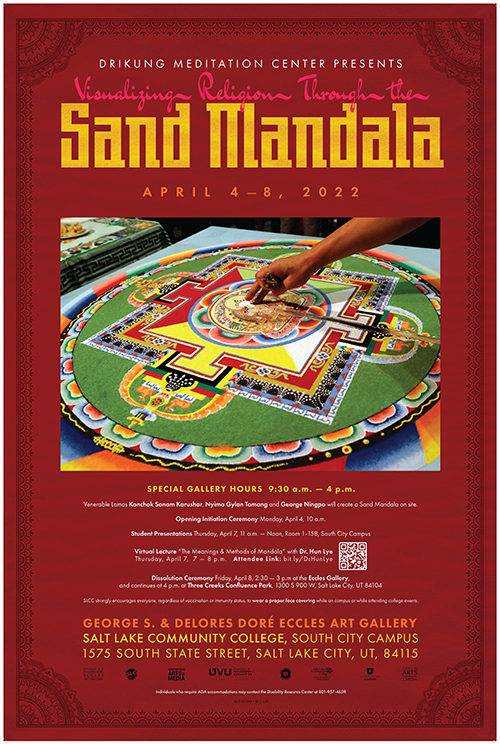 Visualizing Religion Through the Sand Mandala
Visualizing Religion Through the Sand Mandala
A sand mandala is a symbolic representation of Tibetan Buddhist philosophy, & a type of meditation monks use to develop wisdom. Constructed with millions of grains of colored sand, the mandala takes at least a week to construct.
This is a rare educational opportunity to learn more about this process & product of Tibetan Buddhist artistic, cultural, and religious expression as well as the use of visual tools & techniques in other cultures.
Venerable Lamas Konchok Sonam Karushar, Nyima Gylan Tamang and George Ningpo will create a Sand Mandala on site.
Monday, April 4
- 10 a.m.
- Opening Initiation Ceremony
Tuesday, April 5
- 9:30 a.m. - 4 p.m.
- Exhibit open
Wednesday, April 6
- 9:30 a.m. - 4 p.m.
- Exhibit open
Thursday, April 7
- 9:30 a.m. - 4 p.m.
- Exhibit open
- 11 a.m. - 12 p.m.
- Student Presentations
- Room 1-158, South City Campus
- Student Presentations
- 7-8 p.m.
- Virtual Lecture "The Meanings & Methods of Mandala" with Dr. Hun Lye

Friday, April 8
- 9:30 a.m. - 3 p.m.
- Exhibit open
- 2:30 - 3 p.m.
- Dissolution Ceremony
- at the Eccles Gallery
- Dissolution Ceremony
- Continues at 4 p.m.
- Dissolution Ceremony
- Three Creeks Confluence Park, 1300 S 900 W, Salt Lake City, UT 84104
- Dissolution Ceremony
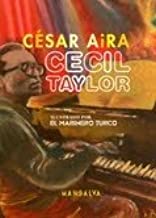
"Transmedial Ekphrasis: César Aira’s 'Cecil Taylor'"
Cecil Taylor’s experimental jazz exhibited a particular sensibility for transmedial and trans-sensory experience. It is therefore no coincidence that Argentinean writer César Aira would turn to the iconoclastic musician to stage his own version of transmedial aesthetics. In this talk, Professor Graff Zivin examines the incorporation of Taylor's method and aesthetic into Aira's work. By opening the literary text to music in a way that does not reduce it to a representation, Aira stretches the limits of a what a literary text can do, exposing the unrepresentability necessarily at the heart of literary discourse. Considering W.J.T. Mitchell’s argument that “the ekphrastic image acts… like a sort of unapproachable and unpresentable ‘black hole,’” Graff Zivin asks what role “black holes” and blackness more generally might perform in ekphrastic aesthetics, in dialogue with Deleuze and Guattari, Evelynn Hammonds, Fred Moten, Rizvana Bradley, Zakiyyah Iman Jackson, and Tavia Nyong’o.
Erin Graff Zivin is Professor of Spanish and Portuguese and Comparative Literature at the University of Southern California. Her work focuses on modern and contemporary Latin American literature and media, the relationship between ethics, politics, and aesthetics, and the intersection of philosophy and critical theory more broadly. She is the author of several books, including Anarchaeologies: Reading as Misreading (Fordham University Press, 2020) and Figurative Inquisitions: Conversion, Torture, and Truth in the Luso-Hispanic Atlantic (Northwestern University Press, 2014). She has also edited or co-edited several books and journal dossiers, including Terror: La perspectiva hispana (Guillermo Escolar, 2020), The Marrano Specter: Derrida and Hispanism (Fordham University Press, 2017), The Ethics of Latin American Literary Criticism: Reading Otherwise (Palgrave Macmillan, 2007).
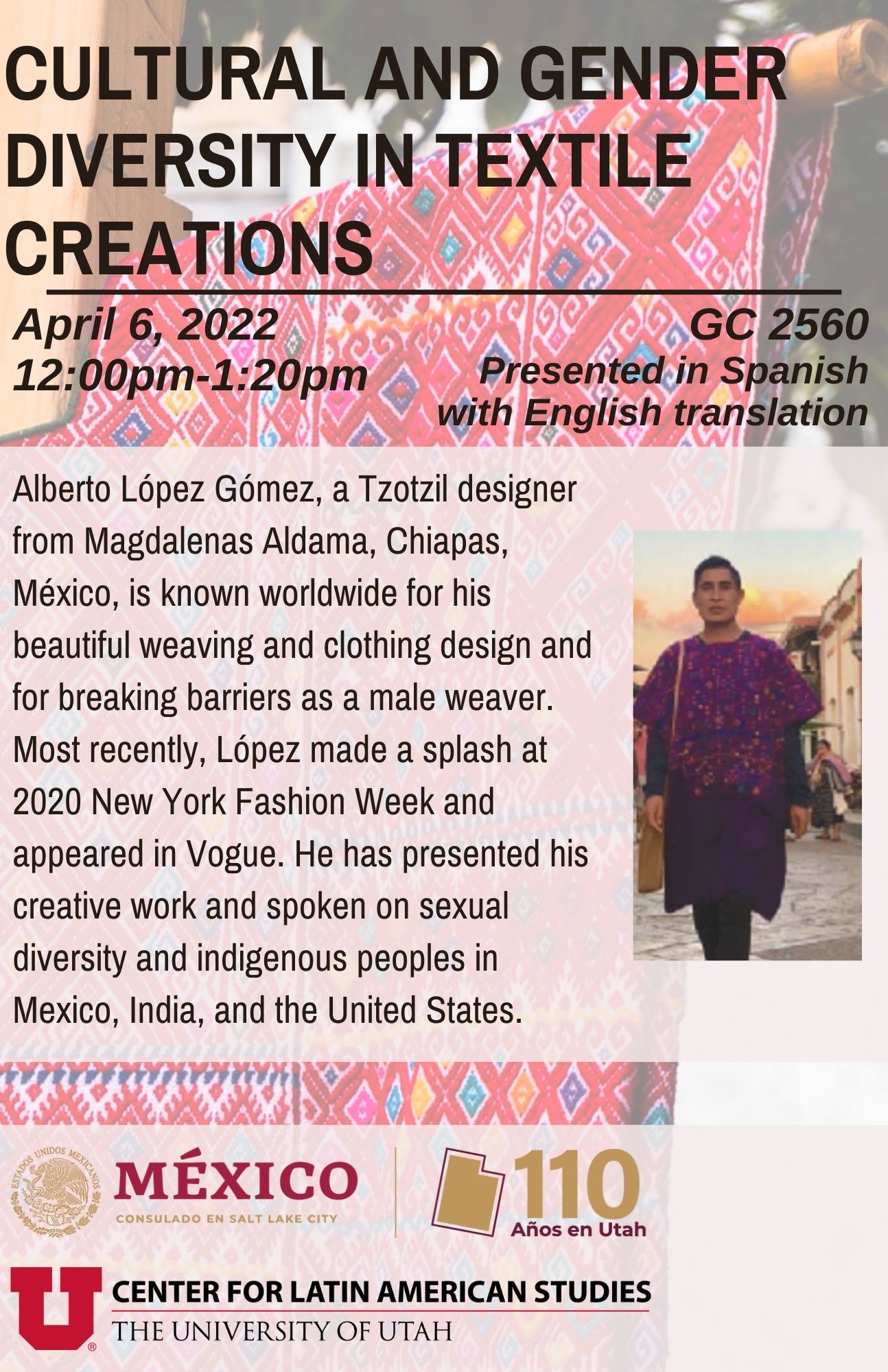
Alberto López Gómez, a Tzotzil designer from Magdalenas Aldama, Chiapas, México, is known worldwide for his beautiful weaving and clothing design and for breaking barriers as a male weaver. Most recently, López made a splash at 2020 New York Fashion Week and appeared in Vogue. He has presented his creative work and spoken on sexual diversity and indigenous peoples in Mexico, India, and the United States.

My Path: Q&A with ALberto Lopez
My Path: between colored threads, cultural heritage, gender diversity and entrepreneurship.
Alberto Lopez is a Mexican, Mayan Tzotzil from Aldama, Chiapas. He is a world renowned fashion designer who shares his talent and devotion to his cultural heritage.

Strong Interpretations in Translating Classical Chinese Poetry: Against the Grammar-Translation Method and “Western Branch Orthodoxy”
Are there better and worse ways to translate classical Chinese poetry into English? Building on my previous publications, in this talk I will argue that the baseline for translating premodern Chinese poetry into English is “strong interpretation.” Introducing the history of debates around classical Chinese poetry translation alongside a look at how other classical literatures—namely Latin, Greek, and Sanskrit—are translated, I will critique one of the dominant modes of translating classical Chinese into English. Since the baseline of translation is strong interpretation, the translations that are most successful are the translations that own up to their interpretations, rather than try to conceal them under the pretense of objectivity.
Lucas Klein (PhD Yale) is a father, writer, translator, and associate professor of Chinese at Arizona State University. He is executive editor of the Hsu-Tang Library of Classical Chinese Literature (Oxford), author of The Organization of Distance (Brill, 2018), co-editor of Chinese Poetry and Translation (Amsterdam, 2019), and translator Mang Ke (Zephyr, 2018), Li Shangyin(NYRB, 2018), Duo Duo (Yale, 2021), and Xi Chuan (New Directions, 2012, 2022).
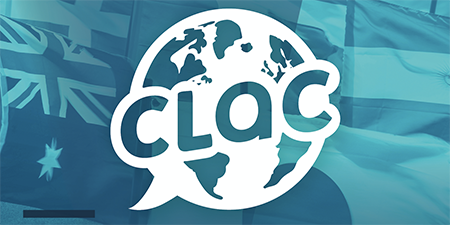
Cultures and Languages Across the Curriculum (CLAC) Info Sessions
| Date | Time | Location | Special Note |
| April 12 | 12 pm | Zoom | Register here to receive link |
| April 14 | 2 pm | CTIHB 201 |
Going Global Career Panel: Identities at Work
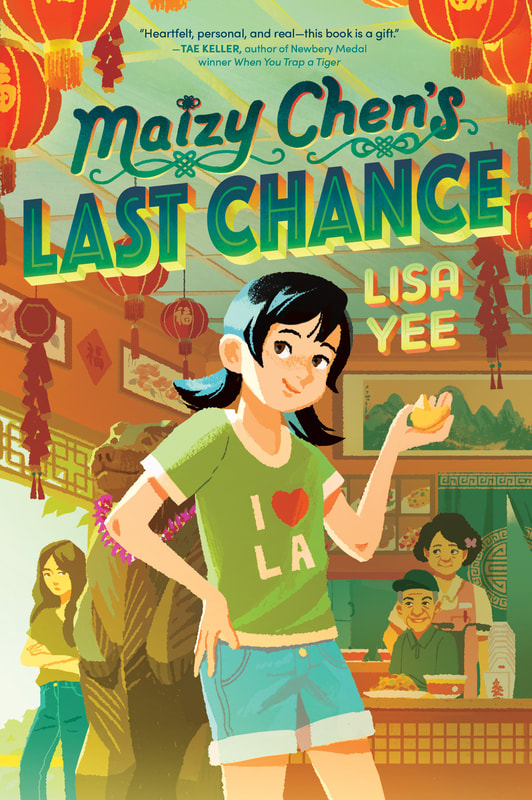
Not a lot has been written about the Chinese American experience in children's literature. Here, Lisa Yee explores why she wrote her novel, the research going back and forth from the 1800's to present, and what she learned along the way.
Lisa Yee was born and raised near Los Angeles. As a kid, she loved reading, opening brand new boxes of cereal (to get the prize), and riding the teacups at Disneyland. Even though Lisa has been paid to eat chocolate, the thing she likes doing most is writing--except for when she has writer's block, or needs a snack, or is distracted. Her latest work Maizy Chen's Last Chance, debuted in February 2022. According to Yee, “Out of the 21 novels I've written, this is my most personal book so far. Like Maizy, my story began in China - a place I’ve never been to. Like Maizy, I'm a Chinese American from Los Angeles. And, like Maizy, when I was 11-years old I knew little about my family history.” This novel is a work of fiction about a contemporary girl. But it’s also about Maizy's family, the owners of the Golden Palace restaurant and, for generations, the only Asian Americans in Last Chance, Minnesota.
